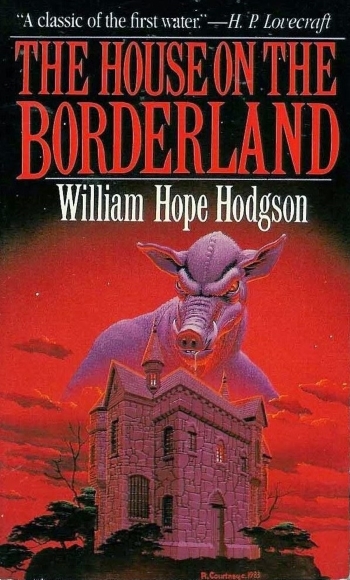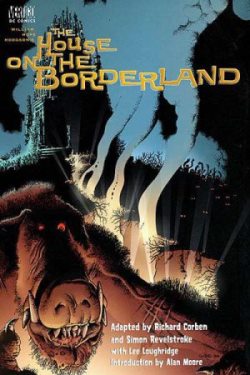
The House on The Borderland
by William Hope Hodgson
Carroll & Graf Publishers, 1983 (Original Publication, 1908)
186 Pages
Young Adult (13 and up)


I was excited to have finally found a cheap copy of this at a library sale, as it has been on my “to be read” list forever. It is a classic horror novel in the family of weird fiction belonging to H.P. Lovecraft, Manly Wade Wellman, and Robert Chambers. The story begins with an amazing premise, almost science fiction, but certainly overwhelmingly gothic: a ruined castle is all that stands between a man, his sister, and his dog… and an army of pig-men from the abyss!
It is a short book, less than 200 pages, so I dove right in. Unfortunately, I was profoundly disappointed in the overall novel. I’m going to fill this review with spoilers so that I might save you the pain of actually reading the nonsensical narrative yourself.
At first it is perfect; a lost diary found in creepy old ruins describing a surreal encounter with otherworldly beast men. A nameless man purchases the ruins of an old castle in the far reaches of rocky Ireland cheap, because the locals claim it is “of the fairies,” and shun it as an evil place. He discovers, at the far end of what he terms his house’s gardens, an underground river flowing into a deep chasm. There is a landslide, and he soon encounters pig-headed creatures that lay siege to his castle. His dog Pepper takes a bone-deep hit from the first unseen Pig-man.
During this time he has a vision that carries him to a far-off world where an exact replica of his house stands, there also visited by pig-men, and surrounded by ancient statues and alien animal-like creatures.
After the night-long siege, the pig-men simply disappear. The threat just walks away after nearly breaking into his castle. His sister has gone quite possibly mad, her mind rejecting the terror she has seen, but she has nursed Pepper back to health after that first wound.
Meanwhile back at the pit, another landslide reveals a cave in the wall of the chasm, and the man cannot resist his curiosity to explore it. There, needlessly armed as fully as he is capable against the now absent pig-men, he discovers what appears to be a bottomless pit reaching to the core of the Earth directly beneath his home! When a torrential rainfall outside causes the cave to flash-flood, he is almost swept into the pit! But his loyal Pepper saves him, (and then the dork can’t even remember to untie his companion who is leashed to a tree as he staggers home.)
At this point the novel turns. Another vision comes, but instead of flying directly to the copper-skied world where the house also simultaneously stands “en-rapport,” our protagonist embarks on a out-of-body journey of cosmic horror, so vague as to be frustratingly confusing. A good half the book is wasted describing how time advances increasingly rapidly so that eons float by in minutes; we watch as the sun extinguishes and the Earth and our sun float away. Then weird bubbles with faces in them float by, and a giant green star appears. Finally, (finally!) we are returned to the house at the other world orbiting the central star of reality (this was written before science understood that black holes were at the center of galaxies,) and he awakes in his armchair.
Pepper, we discover, has indeed died quietly of old age, (turning to dust as he had in the vision,) proving the reality of the journey, but the strangely glaring omission of what happened to the protagonist’s sister during the time-bending vision brought me right out of the narrative. He eventually mentions one last time that she is alive, but nothing as to why Pepper was affected by the time-shift and not his sister or himself, and why he alone was a witness.
I had to laugh at the footnotes supposedly made by the people who found the lost diary, because Hodgson obviously felt it necessary to explain the nuances of the surreal celestial events as if we could actually follow some meaning behind the nonsense he is describing.
One review I read said that Pepper was the most likeable character in the novel. This is for certain. This jerk buys another dog after Pepper dies, and leaves it outside as an early warning for pig-men. The poor thing is of course attacked, and is infected by some magic brought by a glowing pig-man from the other world. This jerk deserves to be infected himself and to have his face to turn into fungi!
Despite my dislike of the cosmic travels, apparently Lovecraft himself found the description to be influential. I did indeed understand the horror of being forced to watch as not only your beloved family returns to the ashes, to discover a pile of dust that was once your own flesh, but to witness your entire planet die, to see the sun go out, and to understand the immensity of the universe first-hand.

Finding myself so disenchanted with the source material, I could not keep myself from searching for what others have seen in the story. True to my suspicions, the graphic novel version illustrated by Richard Corben has taken liberties to adapt the original narrative. (Yes, Corben fans, there are some very adult scenes in it). They ignore the cosmic horror aspect entirely, and focus on the timeless stone house built of otherworldly material attacked by pig headed beasts from an ancient cavern. The sister goes mad. Pepper dies.
The graphic novel offers a much more satisfying end than the book, and the illustrations are truly magnificent, frightful renditions of the story. I believe it was nominated for an award.
